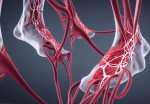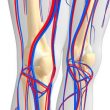Results of infrapopliteal territory revascularization in critical limb ischemia. Compared against the general population, patients suffering from critical lower limb ischemia (CLI) not only experience seriously limited quality of life, but also face a significant higher risk of death and amputation. Specifically, the optimal treatment for these patients remains uncertain. This uncertainty was sparked by...
Deep Vein Arterialization: Have We Conquered “Non-Revascularizable” Critical Limb Ischemia?
Deep vein Arterialization in patients with critical “non-revascularizable” limb ischemia. We are familiar with the poor quality of life and elevated mortality of patients with chronic limb-threatening ischemia (CLTI). In its last stages (nearly terminal), revascularization (either surgical or endovascular) has been shown to reduce amputation incidence. However, similarly to heart disease and other vascular scenarios,...
BEST-CLI: Revascularization of Critical Lower Limb Ischemia, a Pragmatic Study
Critical lower limb ischemia (CLLI) is associated with a major deterioration in quality of life and a significant increase in morbidity and mortality. Its estimated annual incidence is 220 to 3500 cases per million people, with an expected prevalence of 11% of patients with peripheral arterial disease. CLLI is the “terminal” stage of peripheral artery...
Should We Start Using the Retrograte Access in Critical Limb Ischemia?
Courtesy of Dr. Carlos Fava. Peripheral vascular disease in lower limbs is on the rise. Antegrade recanalization is associated with amputation and death, and therefore contraindicated. For a while we have been using the retrograde access when classic revascularization is not possible. Even though there is evidence in favor of this access, it is just...
Frailty: What Happens When We Are Too Late in Critical Lower Limb Ischemia
This condition, now “trending” among patients undergoing transcatheter aortic valve replacement (TAVR), has expanded to almost all patients we treat, always with the same outcome: the prognosis is bad, so bad that it might warrant making the difficult decision of not going forward. The association between frailty and bad prognosis is easy to see and...
Frailty and Critical Limb ischemia: Facing a New Challenge
Courtesy of Dr. Carlos Fava. Critical limb ischemia is the final stage of peripheral vascular disease and is associated to pain at rest, trophic lesions, and gangrene. It is also associated to amputation and reduced mobility. When it happens in frail patients, it presents a challenge. This population is on the rise and there is...
What Is the Prognosis for Reinterventions in Critical Lower Limb Ischemia?
Infrapopliteal (below the knee, BTK) percutaneous transluminal angioplasty (PTA) has been acknowledged as a useful strategy in chronic critical limb ischemia (CLI), but artery calcification severity results in considerable restenosis. Repeat PTA and the management of trophic lesions help with wound healing. However, this conduct has not been extensively assessed. This study enrolled 152 patients (175 limbs)...
Critical Lower Limb Ischemia Should Be Taken into Account in TAVR
Courtesy of Dr. Carlos Fava. Peripheral vascular diseases (PVD) present the same risk factors as aortic stenosis. In consequence, these disorders usually coexist. The frequency and impact of their various stages on patients undergoing TAVR is yet to be thoroughly assessed. Read also: “Peripheral Vascular Disease Is Associated to More Events in TAVR”. This study analyzed...
Critical Limb Ischemia: Wound Blush Is the Most Important Objective
The aim of this study was to find the optimal angiographic endpoint for infrapopliteal interventions to be able to predict wound healing. Evidence shows acceptable patency and successful limb salvage in patients with critical limb ischemia after infrapopliteal intervention. However, the optimal angiographic endpoint remains unclear. Is it enough to restore flow in one...
Pedal Artery Angioplasty: Beneficial in Critical Limb Ischemia
Courtesy of Dr. Carlos Fava. Delaying or failing to heal trophic wounds in critical limb ischemia (CLI) changes quality of life, delays rehabilitation and is associated to infections and amputation. Pedal artery revascularization with angioplasty would speed up recovery and improve CLI wound healing. The study analyzed 257 patients with de novo infrapopliteal...








